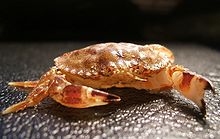Metacarcinus anthonyi
| Metacarcinus anthonyi Temporal range:
| |
|---|---|

| |
Exuvia of Metacarcinus anthonyi
| |

| |
| Metacarcinus anthonyi male | |
| Scientific classification | |
| Domain: | Eukaryota |
| Kingdom: | Animalia |
| Phylum: | Arthropoda |
| Class: | Malacostraca |
| Order: | Decapoda |
| Suborder: | Pleocyemata |
| Infraorder: | Brachyura |
| Family: | Cancridae |
| Genus: | Metacarcinus |
| Species: | M. anthonyi
|
| Binomial name | |
| Metacarcinus anthonyi (Rathbun, 1897)
| |

| |
| Metacarcinus anthonyi range | |
| Synonyms | |
|
Cancer anthonyi Rathbun, 1897 [1] | |
Metacarcinus anthonyi, the yellow rock crab or yellow crab, is a species of edible crab native to the Pacific coast of North America.
Distribution
Metacarcinus anthonyi occurs from
Some fossils of M. anthonyi are also known from central and southern California, dating from the Pliocene and Pleistocene.[2]
Description
Male yellow rock crabs can reach 165 mm carapace width, while females reach 148 mm.[4] The carapace is oval, fairly broad, and widest at the 9th of 10 forward-curving anterolateral teeth. Like other California Cancridae crabs, M. anthonyi has black-tipped claws. M. anthonyi can be distinguished from Romaleon antennarium by its lack of red spotting on its underside. M. anthonyi also tends not to decorate itself and tends not to have hairy legs. It can vary in coloration from yellow to brown with the juvenile crabs tending to be darker than adults.
Metacarcinus anthonyi is one of only two species that regularly reach the
Ecology and life cycle
Metacarcinus anthonyi is an ecologically important species. It is prey for many fish including the
.Metacarcinus anthonyi reaches sexual maturity after 10–12 molts.[5] Mating typically takes place in June, and occurs shortly after the females have molted.[2] Before molting, females release a pheromone which induces courtship behavior in the males.[2]
Taxonomy
Metacarcinus anthonyi was
Fishery
Metacarcinus anthonyi is harvested by sport and commercial fishermen in California, mostly from
References
- ^ PDF) on 2011-06-06.
- ^ ISBN 978-0-8047-1045-9.
- ^ ISBN 978-0-520-05924-5.
- ^ Carroll, Jay; Winn, Richard (1989). "Species Profiles: Life Histories and Environmental Requirements of Coastal Fishes and Invertebrates (Pacific Southwest)". U.S. Fish Wildl. Serv. Biol. Rep. 82 (11.117): 16.
- ISBN 978-1-879906-57-0.
- ISBN 978-0-8018-9304-9.
- ^ Parker, David O. (December 2001). "Rock Crabs". Retrieved September 10, 2013.
